|
|
Lord Clifden

|
|
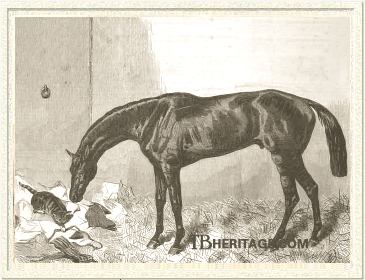 |
|
|
Lord Clifden was top runner at age three, barely -- many held not --beaten in the Derby, and triumphant winner of one the most exciting St. Legers ever run. He was a slow starter at stud that died comparatively early, but proved a good stallion with sire sons that made a mark in France, the U.S., in steeplechasing, and, in England, one that carried the Newminster line forward to the present day. In addition to winning the Doncaster classic, he uniquely got four winners of that race.
Lord Clifden's dam, The Slave (1852), was by Melbourne, a good staying horse that surpassed himself in the breeding shed, getting seven classic winners and twice topping the leading sire's list. Bred at the Royal Stud at Hampton Court, The Slave was the second foal of the Voltaire daughter, Volley (sister to Voltigeur), whose first produce was the good staying winner Grapeshot (1850, by Alarm). She was purchased for 70 guineas as a yearling at the Hampton Court sale by J.A. Hind, a wine and spirit merchant who lived at Ashton-under-Lyne in Staffordshire, according to Henry Custance the only broodmare Hind owned. She ran three times as a juvenile, placing once at Radcliffe. At age three she was bred to Touchstone, dropping a bay colt, Silverdale, in 1856. Her next Touchstone foal died two days after his birth in 1857. She was then bred to Touchstone's son, Derby and St. Leger winner Surplice, and dropped a filly, Lady Clifden, in 1858. She had a foal by an unknown stallion in 1859, that died when a few days old, and then in the spring of 1859 she was sent to Rawcliffe Paddocks, and the next year she dropped Lord Clifden to the cover of Newminster. In 1861 she was bred to Mountain Deer, but did not catch, and she proved barren for four years, until 1865, when she produced her last, a foal by Newminster or Leamington.
Running as a juvenile for her breeder, Lady Clifden won Liverpool's five furlong Tyro Stakes by a neck, beating Big Ben, Dundee and a field of ten others. After that, she was purchased by Captain Christie, a former Grenadier Guard that served in the Crimea and had been raised at Quenly Hall, Leicestershire, where his father, John, kept "the finest studs of hunters known in that country." The Captain's specialty, with his associate and trainer, the Stanton-based Tom Wadlow, was buying, developing, and racing sprinters. At age three, Lady Clifden won the five furlong Portland Handicap and other races, and ran third in the Fitzwilliam Stakes (won by the six year old Cosmopolite, with the great Tim Whiffler second). At age four, frequently referred to in the sporting press as "the flying Lady Clifden," she won Goodwood's Stewards Cup over six furlongs and other sprint races, and at age five won five races, always carrying over 9 st. and the heaviest weighted, including the County Cup at Lewes over the Two-Year-Old course and the Revival Purse at Doncaster. She was sold at Doncaster for a huge sum, purchased by John Jackson and installed at his Fairfield Stud in Yorkshire, where she was bred to Neptunus and Blair Athol (standing there at the time), in sucessive years, managing to produce two indifferent runners, Neptune (by Neptunus) and Ben Macdui (by Blair Athol), and several unnamed foals before, "ragged as a pauper," she died not long after producing a foal in 1873. In addition to speedy flat runners, Christie owned some steeplechasers, including The Dane, that ran second in the Grand National Steeplechase to Jealousy in 1861.
Lord Clifden's sire, Newminster was a lightly-raced, "delicate" winner of the Doncaster St. Leger. He was twice leading sire in England, and never lower than tenth, after his first crop were three-year-olds. Lord Clifden and Derby winner Hermit, later seven times leading sire, were his best sire sons, but it was Lord Clifden, through his son, HAMPTON, that carried the sire line to the present.
Lord Clifden, a "hard bay without a white hair," was "the biggest and hardest of all Newminster's sons. Like many Newminsters, he resembled his dam's sire (Melbourne) more than his sire, and had the somewhat plain head and almost lop-ears of his famous grandsire "...he was Melbourne all over, albeit certain of the exaggerated characteristics of his maternal grandam were toned down, rounded off, and smoothed away." The stud groom at Moorlands, later described him as "combining the quality of his sire, with the size of his maternal grandsire." Destined to be a comparatively tall horse, like Melbourne and unlike Newminster, he was very much on the leg as a younger horse, and did have long cannon bones, although that appearance disappeared somewhat after he was let down when he went to stud. While he looked light-legged, his bone below the knee measured 8-1/2 inches. He was known for his long stride, but, like Newminster, he did not have the best hind end for negotiating the course gradients of Ascot and Newmarket, which is clearly seen in his race record. He was a docile horse of "no bad temper whatever."
Lord Clifden on the Turf
Placed in training with Edwin Parr, Lord Clifden's first start was for his owner-breeder J.A. Hind at Epsom, where he won the Woodcote Stakes, beating The Orphan by two lengths, with thirteen others in the field. He had a bad start, something that became a bit of a habit with him, and was ten lengths behind the leader when he picked up to win the race. This was not a surprise to his connections, since he had shown in a trial against Spicebox and Egyptian at Chester that he could beat winners in good form at even weights.
After that race, Captain Christie, who had had such success with his half-sister Lady Clifden, spent a good deal of money -- £4,000 -- to purchase Lord Clifden, but Lord St. Vincent, who owned Woodcote runner-up, The Orphan (later died from tetanus), had determined to buy the horse, and after a couple of weeks of haggling, Lord St. Vincent secured Lord Clifden for 5,000 guineas, with 2,000 more if he won the Derby; Christie split his quick profit with his trainer, Wadlow.
Lord Clifden's next outing was in the fall of his juvenile year, when he won Doncaster's Champagne Stakes, beating Armagnac by half a length, with Early Purl third and seven others trailing behind. At the same meeting he won a sweep stakes for two-year-olds, with Bohemia second and Queen Bertha (future Oaks winner) third, along with five other youngsters in the race. He was retired to St. Vincent's stud near Canterbury for the season.
|
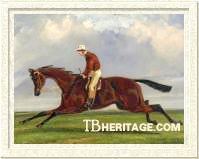
Lord Clifden in the St. Leger
| | At age three Parr trained Lord Clifden on a new course at Telscombe, near Lewes, out of sight of the touts, and in his trials he easily beat the horses Zetland, Necromancer, and Charles Fox. He fell at exercise at one point, and after that would periodically show "signs of lameness," but he was fit and ready for his first race, the Epsom Derby, where he was beaten by a head by the Two Thousand Guineas winner Macaroni. This decision by the judge was hotly contested, and later referred to as Lord Clifden's "ill luck at Epsom." The judge himself said the only different between the two at the finish was that Lord Clifden's head was down, and Macaroni's up, as they passed the post. A consequence of this close, and contested, race was Lord Clifden's subsequent popularity with the racing public, having firmly won "a place in the affections of lovers of the horse." Other runners in the Derby's strong field included Rapid Rhone, Grand Prix de Paris winner The Ranger, Saccharometer, Blue Mantle, Great Ebor Handicap winner Golden Pledge, Hospodar that was juvenile winner of the Clearwell and Criterion Stakes, and over twenty others.
|
In Paris Lord Clifden, part of an English "invasion," ran in the Grand Prix de Paris, but could only run fifth, with The Ranger first, the grand French filly La Toucques (Prix de Diana, Prix du Jockey Club) second and Saccharometer third.
Back in England he won the Doncaster St. Leger in a thrilling race, where he once again had a bad start. The crowds for this Leger were huge and rowdy, complete with traveling menagerie, and jockey Johnny Osborne, who had first been on Lord Clifden only the day before the race, after wending his way through the circus-like crowds, kept the horse apart from the bulk of the field at the start, so that when the flag fell, Lord Clifden was not in the group that left at a "cut-throat pace." Then Blondin slammed against him, and before long, Lord Clifden was fifty lengths behind the entire field, not only due to the bad start, but to his "dawdling and bouncing around" during the first half mile of the race; Osborne was "... the only man in England who could have won on Lord St. Vincent's horse...with exemplary patience he let him plod on till he got to the top of the hill, and then gave him the spurs pretty freely...he began to stride away after this, and his jockey was satisfied what the result would be as soon as ever his horse began to gallop." It was a sensational win, Lord Clifden coming up to beat Queen Bertha by half a length, and a good field (including Blue Mantle, The Ranger, Golden Pledge and Borealis) of eighteen. The crowd went wild, and Parr had to fight his way to the scales for Osborne's weighing-in. St. Vincent won £11,000 in bets on this race. At the same meeting Lord Clifden "easily" won the Doncaster Stakes, beating four others.
Lord St. Vincent switched trainers at the end of the season, sending Lord Clifden to William Bevill, an amateur jockey whose successes had primarily been on steeplechasers. In the spring of 1864 Lord Clifden came out for the Claret Stakes at Newmarket Craven, and was beaten by ten lengths by Rapid Rhone, with the only other horse in the field, Woldga, third. At Ascot he failed to place in the Ascot Gold Cup, "crushed" by Scottish Chief, with The Little Stag (Epsom Cup and Chester Stewards' Cup winner) second, and Voltigeur third. At Goodwood he was again unplaced in the Chesterfield Cup, won by King of Utopia, with twenty four in the field. His last race, such as it was, was a walk-over for 100 sovereigns at Goodwood.
Lord Clifden, then, was a good horse in a year that fielded a number of good runners, but many turfites felt Derby winner Macaroni was the superior racehorse that year. Custance later wrote that Lord Clifden could have done better "had he been in better hands."
Lord Clifden in the Stud
Lord Clifden was retired to stud at George Thompson's Moorlands Stud, at Skelton, near York; his first season was 1866. At the time the 350 acre Moorlands was described as "...one of the completest places of the kind we ever came across...well adapted for breeding blood stock, and the loose boxes and paddocks are arranged according to the best of models." It was conveniently situated within two miles of both the Shipton and Haxby rail stations, and was only four miles from York; with Lord Clifden's success in the Leger, it seemed likely he would be a popular stallion in Yorkshire. He stood along side of Ben Webster, a winner of the Chester Cup.
Lord Clifden was a successful stallion, but not a blockbuster. He got four horses that won six classic races -- HAWTHORNDEN (St. Leger), WENLOCK (St. Leger), PETRARCH (Two Thousand Guineas, St. Leger), and an excellent daughter, JANNETTE (unbeaten at age two and winner of the Oaks and St. Leger).
He started out slowly as a stallion. He was sixth on the leading sire's list in 1870 when HAWTHORNDEN won the St. Leger, but otherwise was absent from the list of the twenty top leading sires in Great Britain until 1871, when he was eleventh. With his comparative lack of success -- his first crop at age two were tepidly received as "at least respectable" -- Lord St. Vincent was persuaded to part with him at the close of 1870, and he was purchased for the fairly dear sum, given his performance at stud to that date, of 4,000 guineas, by Thomas Gee, who was establishing a stud at Dewhurst Lodge, Wadhurst, Sussex.
Gee "...had the courage to take him [Lord Clifden] in hand when at a very low ebb in the eyes of the world of breeders, who condemned him too hurridly and were glad enough to retract their opinions when he had begotten a couple of St. Leger winners, besides numerous other celebrities." Gee, who declared Lord Clifden "the most magnificent thoroughbred he had ever seen," decided to ride with Lord Clifden in his railway box from York, "...so that if the horse were killed during transit he would be killed with him;" likely a wry reference to both the risky sum he paid for the horse and for his admiration for him. Gee later, in 1875, endowed the Dewhurst Stakes at Newmarket, still a premier race for juveniles at that venue.
The year after Lord Clifden went to Dewhurst, WENLOCK (1869) became his second St. Leger winner, affirming that whatever else was going on with HAWTHORNDEN, Lord Clifden could get more than one classic winner. From that year through 1878 (three years after his death) he was never worse than eighth on the list; he was at the top, post-humously, in 1876 -- the year PETRARCH won the Two Thousand Guineas and the St. Leger and HAMPTON the Goodwood Stakes -- was second once, and third and fourth twice.
Lord Clifden got two really good sire sons: Doncaster Cup winner HAMPTON, whose sire line, through his son, Bay Ronald, carries forward to this day, and PETRARCH, a good filly-getter, that was also the sire of The Bard, a successful stallion in France, and of an enormously successful jumper stallion, Hackler. A Lord Clifden son, LORD CLIVE (1875) went to France, where he got a winner of the Prix du Jockey Club and a winner of the Grand Steeple-chase de Paris. Another son, BUCKDEN, went to the U.S., where he got Kentucky Derby winner Buchanan and a number of other good stakes winners. In addition two Lord Clifden sons, BAREFOOT and WINSLOW, became the sires of good steeplechasers, Old Joe and Roquefort respectively, both winners of the Grand National Steeplechase at Aintree. While Lord Clifden got some high class daughters, notably JANNETTE, it is his sons that were most significant, on the turf and in the breeding shed.
|
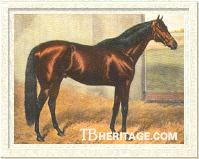
Hampton
| | HAMPTON (1872, Lady Langden by Derby winner Kettledrum), was a slow-maturing, small stayer. He inherited his sire's good constitution and temperament, and was much better managed by being in the hands of trainer Robert Peck. He won the Great Metropolitan Handicap over 2-1/4 miles at age three, carrying only 87 pounds, and the 2-1/2 mile Goodwood Stakes at age four, still lightly-weighted at 108 pounds. At age five, however, he won eight of his ten races, carrying heavy weights, including the Northumberland Plate, the Goodwood Cup, the Doncaster Cup, the Kelso Gold Cup and three Queen's Plates, and at age six won the Epsom Gold Cup and four other races, being virtually handicapped out of some big races.
|
|
HAMPTON, like Lord Clifden, started out modestly as a stallion, but eventually rose in the ranks, getting four classic winners -- Merry Hampton, Reve d'Or, Ayrshire, and Ladas -- and reaching the top of the sire's list in 1887. His son, Bay Ronald, a winner of the Hardwicke Stakes and the City and Suburban Handicap, carried on the sire line through Dark Ronald and Bayardo. Another Hampton son, Star Ruby, was successful as a stallion in the U.S., getting a Belmont Stakes and a Preakness Stakes winner and other good flat runners, and Rubio, the first American-bred horse to win the Grand National Steeplechase at Aintree. Hampton had an important influence through his daughters, also: Perdita II became dam of three full brothers by St. Simon -- Persimmon, Florizel II, and English Triple Crown winner Diamond Jubilee, later a multiple leading sire in Argentina. Hampton's daughter Maid Marian became the dam of Polymelus, five times leading sire in England, that got Phalaris and Pommern.
|
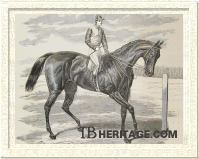
Petrarch
| | PETRARCH (1873, from Laura, by Orlando), universally acclaimed a "beautiful horse," was an erratic runner plagued by kidney trouble, but despite this was game enough to win a number of pretigious races. At age two he won Newmarket's Middle Park Plate, beating a large field. At age three his triumphs included the Two Thousand Guineas, Ascot's Prince of Wales's Stakes, and the Doncaster St. Leger. At ages four and five, lightly raced, his wins included the Ascot Gold Cup and Ascot's Rous Memorial Stakes, punctuated by races in which he failed to place, attributed to his kidney problems. In all, he won eight of his sixteen starts.
|
Some critics noted that PETRARCH tended to get youngsters with bad hocks and light in bone, but regardless, they did win. In the stud, first at Hampton Court and then at Lanwades, three miles from Newmarket, PETRARCH got precocious winning juveniles and four classic winning fillies: Busybody, a good juvenile and a winner of the One Thousand Guineas and the Oaks, later produced another good juvenile in Meddler; Meddler went to the U.S. where he was twice leading sire in that country. Petrarch's daughter Miss Jummy was another good two-year-old; she went on to win the One Thousand Guineas, the Oaks, the Nassau Stakes and the Park Hill Stakes, all premier events for three year old fillies. Throstle won the Doncaster St. Leger, continuing the Newminster sire line's dominance of that event; in the stud she bred Missel Thrush, grandsire of the good Irish-bred jumper stallion Jackdaw. Petrarch's French-bred daughter Presta won the Prix de Diana. Many of PETRARCH'S other daughters were good winners and went on to have an influence in the breeding shed: Derby winner Sunstar, Oaks winner Princess Dorrie, the grand producer Plucky Liege, and One Thousand Guineas winner Quintessence (dam of Paragon and Clarissimus), were children and grandchildren of PETRARCH daughters.
PETRARCH'S small, game son, The Bard was an unbeaten winner of sixteen races at age two, and was second only to the great Ormonde at age three, winning six races, including the Goodwood and Doncaster Cups. He went to stud in France, getting six classic winning cots and fillies there and leading the sire's list twice, but he failed to establish a lasting sire line there. PETRARCH'S other significant sire son was Hackler, not a stellar racehorse, but in Ireland a sire of three classic winners. Hackler was also a superior sire of chasers and hurdlers, getting two winners of the Grand National Steeplechase and many other good jumpers.
|
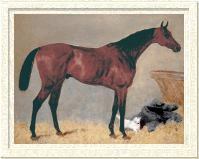
Hawthornden
| | HAWTHORNDEN (1867, out of Bonny Blink, by The Flying Dutchman) was a narrow, leggy, wiry blood bay, 15.3. hands high, a bit upright with a somewhat straight shoulder, and back at the knees; he had good hocks and lots of bone, but like his sire, was weak in the back and loins. American turf writer Thomas Merry said "He was about as long-backed and badly put together a brute as I have ever laid eyes on and how he ever won anything above an over-night selling race passes my comprehension." Bred by Durham farmer George Heslop out of the unraced Bonny Blink, he was sold as a yearling for 250 guineas to Mr. Heene, but Heene fell ill and sold his horses in training, including Hawthornden, at Tattersall's the Thursday before the Derby of 1870. He was knocked down to Newmarket trainer Joseph Dawson for 900 guineas, who purchased the horse for his client, T.V. Morgan. He was a decent juvenile, and an average runner in a year of largely middling animals at age three.
|
HAWTHORNDEN won three of his four races at age two: Newmarket's Gladiateur Stakes, beating Prince of Monarque and two others; a stakes for juveniles at Reading, beating Stockhausen and six others, and a race for juveniles at Huntingdon, where he triumphed over a pretty good field that included the Ascot Biennial winner Pandore, Cestus, Religieuse, Florian and two others. At Newmarket he was third in the Prendergast Stakes, won by Clearwell Stakes winner Atlantis, with Atlas second, and five others in the field.
At age three he failed to place in Macgregor's Two Thousand Guineas, just a neck out of third, behind Kingcraft, who would win the Derby. He went to Ascot, where he failed to place in the Queen's Stand Plate, won by the two-year-old King of the Forest; future City and Suburban winner Digby Grand was third, and the good horse Rosicrucian was also in the field unplaced. Next was Goodwood, where the five year old Typhaeus won the Stewards' Cup, beating Tabernacle (by Newminster), and Plaudit (by Thormanby) and Cymbal (by Kettledrum) dead-heating for third, Hawthornden unplaced. Hawthornden did, however, take a walk-over for the Rous Stakes at that meeting, but then failed to place in the Chichester Stakes, won by Tibthorpe (by Voltigeur). That was his record when he entered the Doncaster St. Leger as a huge longshot (1000 to 35).
At Doncaster, in a bitterly cold afternoon, where the best horse of the year, Macgregor, was not in evidence, having broken down, and the favorite, Derby winner Kingcraft, was not considered a very good horse, the crowds were sparse. The race, with nineteen runners, was disrupted by numerous false starts, and one horse, Sunlight, broke the bones in his fetlock while leading at a very fast clip, just 300 yards after the much delayed start and had to be shot. Several horses ran out of steam while Kingcraft and Hawthornden's jockeys held back at the end of the pack, biding their time, and then Kingcraft made his move, with Hawthonden close behind. Hawthornden caught Kingcraft in the end, winning by half a length, in an exciting finish where Kingcraft's jockey mericlessly whipped his horse to try to shake off Hawthornden. According to one authority, "The Ring," a betting partnership of more than dubious repute, was delighted with his win, which raises questions regarding its authenticity. It was one of the slowest St. Legers on record.
Hawthornden went to Newmarket in the fall, but failed to place in the Cesarewitch (won by Cardinal York, by Newminster) in a field of over thirty, and likewise did not place in the Cambridgeshire (won by Adonis, by Grimston), in a field of over forty horses.
At age four Hawthornden ran once, winning the High Level Handicap, carrying 9 stone, with six other more lightly weighted modest runners in the field. At age five he failed to place in Inveresk's Chester Cup, "a very moderate field," but did pick up the Cheshire Stakes handicap, beating four others by two lengths. Also at Chester, in his last career start, he was second to a filly, Day Dream (by Crown Prince) in the Steward's Cup, beating one other horse.
HAWTHORNDEN did virtually nothing in the stud in England, getting a few horses that ran as hunters. In 1874 he was purchased by Australian-born Frank Dangar, a British-based livestock agent for his elder brothers, the Dangar Brothers, William John and Albert Augustus. The family had vast holdings in the Hunter Valley in New South Wales, and were prominent breeders of both thoroughbreds and arabians. In Australia he was not particularly successful, his only good runner the brown colt, Sunset (1875, out of imported Sunshine, by Weatherbit), that won the VRC Essendon Stakes (16 furlongs). Several of Hawthornden's daughters produced some good winners in Queensland and Perth, notably Algerine, who bred Barbarossa (WATC Perth Stakes and Imperial Stakes) and his gelded brother Massinissa (1894, VATC Toorak Handicap and Memsie Stakes (dead-heat)). Hawthornden was shot at the Dangar stud farm, Neotsfield, in 1891, "being worn out."
|
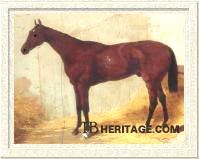
Wenlock
| | WENLOCK (1869, from Mineral by Rataplan) won one race, the Doncaster St. Leger, for his amateur sportsman owner, Thomas Egerton, (third) Earl Wilton, who had owned Gladiator, and would later own Cambridgeshire winner See Saw. WENLOCK'S dam, Mineral, a winner of four minor races, was by the good stayer and sire Rataplan. WENLOCK was her first useful foal; after him came his sister, SILURIA (1870), tail-female ancestress of the good handicapper Willonyx, and the important American matron Boudoir (ancestress of Your Host, Secreto and Majestic Prince). Sold in 1871 in foal to Adventurer, Mineral went to Hungary where she dropped a colt, the future Deutches Derby winner Schwindler (1872, by Adventurer), and the following year she produced Kisber (1873, by Buccaneer), winner of the Epsom Derby and the Grand Prix de Paris and later a good sire.
|
Trained by Tom Wadlow, WENLOCK'S first race was the Two Thousand Guineas, won by Favonius, where he was unplaced. Next was the Epsom Derby, won by Captain Henry Savile's Cremorne, where Wenlock ran fourth. At Ascot in June, he was unplaced in the Prince of Wales's Stakes, but two days later he managed second in the All-aged Stakes. He did not appear again until September at Doncaster, where, "sent to the post in perfect condition," he took the St. Leger, with the previous year's juvenile champion Prince Charlie second, and fifteen others in the field; Cremorne, the best horse of that generation, due to an oversight, had not been entered. WENLOCK had been scheduled for a match against Favonius in October of that year at Newmarket Houghton, but paid forfeit, the general consensus being that he went "amiss," and he did not run at all at age four, but came out in March of 1875 to run in the Lincolnshire Handicap, unplaced, after which he was retired from the turf.
WENLOCK joined Cremorne at Savile's Rufford Abbey stud in Nottinghamshire, where Parmesan was a stallion and where Cremorne had been born and then returned to stand at stud. In 1891, Wenlock, age 22, was sold to the U.S., but on August 21 died at sea, enroute to America.
WENLOCK was a more useful sire of runners than is generally credited, and he was arguably one of the most significant broodmare sires in the history of the breed. His best runner was probably Panzerschiff (1884, Spiegelschiff by Speculum), winner of Doncaster's Champagne Stakes and Goodwood's Richmond Stakes as a juvenile, and of the 1-1/2 mile Great Yorkshire Stakes at age three; he was later sold as a stallion to Austria-Hungary, but was not a success. From Duvernay (by Beadsman) WENLOCK got Limestone (1878), a winner of Goodwood's Sussex Stakes, and his brother Quicklime (1879), winner of Ascot's Prince of Wales's Stakes in 1882, second in the Two Thousand Guineas and Epsom Derby, and winner of Epsom's City and Suburban (1-1/2 miles) at age five; Quicklime stood in Lincolnshire for a few years and was later sold to the U.S. as a stallion.
WENLOCK'S sons Abingdon (1887, out of Lady Langden-Kettledrum), Cyrus (1884, from Teardrop-Scottish Chief), Martenhurst (1888, from Hirondelle-Adventurer), and Deceiver (1880, out of Boot and Saddle-Trumpeter) were also all sold to the U.S. Martenhurst, in California, promised to be useful, but died after only one season at stud. Of the rest, Deceiver was the most successful; among his progeny was Puryear D. (1889, from Ada D.-Enquirer), winner of the Straus Stakes at Lexington and the Tobacco Stakes at Louisville. Puryear D was later sire of California sugar baron Adolph Spreckel's tough -- but perpetually lame -- colt, Dr. Leggo, fast winner of the California Derby, Ascot Derby, the Burns Handicap and the Christmas Handicap; standing at Spreckel's Napa Stud in California's Napa Valley, Dr. Leggo got a number of good runners, and was a successful broodmare sire, but the sire line disappeared.
WENLOCK'S primary contribution to thoroughbred bloodlines was through some of his steller broodmare daughters. First of these was the unraced Dead Lock (1878, from Malpractice by Chevalier d'Industrie); she produced Gervas and Islington (the latter sent to the U.S. at age five and installed as a stallion at James Robinson's stud at Halford), useful runners, and then dropped the outstanding racehorse Isinglass, unbeaten at ages two, and four, winner of England's Triple Crown at age three, and of the Ascot Gold Cup, his only race, at age five. Isinglass later got three classic winners, and two significant sire sons, John o' Gaunt, sire of Swynford, and Star Shoot, five times leading sire in the U.S.
WENLOCK'S daughter Sanda (1878, Sandal-Stockwell), placed in some races in her three seasons on the turf, and won over jumps. In the stud she bred Epsom Derby winner Sainfoin (1887, by Springfield), sire of the English Triple Crown winner Rock Sand (sire of Mahubah, Man o' War's dam) and of good broodmare daughters, including Bromus, the dam of that influential breed-maker, Phalaris, and Tout Suite, the dam of an important modern source of stoutness in thoroughbreds, Hurry On. Sanda also produced the good runner Black Sand (1897, by Melanian), winner of the Cesarewitch Stakes and Newmarket's Jockey Club Cup among other races, and her daughter, Sierra (1889, by Springfield) produced the speedy Sundridge (1898), an important stallion, and his sister, the good winner Amphora (1893), whose daughter Flaming Vixen carried forward a successful branch of Family 2-g.
WENLOCK also got Rinovata (1887, from a Rufford Abbey-bred broodmare, Traviata, by Cremorne), a winner of Newmarket's Heath Stakes and placed in some other races at age three. She produced seven winners, including Flume, winner of Ascot's Trial Stakes (Queen Anne Stakes), and Donnetta, who won 13 of her 47 starts, including the Duke of York Stakes and the Kempton Park Great Jubilee Handicap. Donnetta was later was an outstanding broodmare, dam of One Thousand Guineas winner Diadem, Two Thousand Guineas winner Diophon (later sire of Theresina), the high-class handicapper Diadumenos, Donnina, a winner in Italy that established a successful female family in the stud of Federico Tesio, and Tiara, a good broodmare in France. Donetta's daughter Renaissance, a winner of two races in 27 starts, later produced the flying Cos, winner of all but one of her seven juvenile starts and later dam of another flyer, Mrs. Rustom and of Rustom Pasha, a good winner and sire.
WENLOCK'S other daughters included Wedlock (1884, Cybele-Marsyas), the dam of Best Man (1890), winner of Epsom's Queen's Prize, Newmarket's July Cup and All-Aged Stakes and of the Prix du Conseil Municipal at Longchamp, later sire of the tough juvenile Stolen Kiss (dam of champion filly Straitlace and other good winners); Mocassin (1876, sister to Sanda), dam of Migräne, a winner in Germany of the Preis der Diana and the Hertefeld-Rennen; Stocklock (1880, out of Black Stocking-Stockwell), dam of Liverpool Autumn Cup winner Chubb; Sorcery(1877, from Christabelle-Fernhill), who bred two winners of the Austrian Derby; and a number of other daughters that produced winners and bred on.
Lord Clifden's son BUCKDEN (1869, Consequence by Bay Middleton), was bred at Frederick Thompson's Poppleton Hall in York, out of a mare that had raced once unplaced as a juvenile. He was sold, and imported as a yearling by the American partnership of William R. Travers (as in "Travers Stakes") and John Hunter, who just six years earlier had founded the Saratoga, New York, race meetings, with Travers as president and Hunter as one of the stewards. BUCKDEN, "a lenghthy and handsomely turned" colt, was a speedy horse and ran mostly in one mile to 1-1/4 mile "dashes," rather than the longer cups and multiple mile heat races that still dominated American racing, although his best win was over two miles. He passed this speed on to his youngsters, that were also known for their precociousness, contributing, in a modest way, to the development of the fast, short-distance American thoroughbred.
The rich bay colt ran at ages two and three for Hunter and Travers on New York courses. In his first and only outing as a juvenile, just six months after arriving in the U.S., the Hopeful Stakes at Monmouth, he got off poorly, and was second to the filly Malita, by Marion. At age three BUCKDEN won three of his ten races, including a $500 purse over a mile at Baltimore, a 1-1/8 mile race for three year olds at Jerome Park, by ten lengths, and dead-heating with Grey Planet (by Planet) in a 1-1/2 mile dash for three year olds at Saratoga, on the same day as the famous Saratoga Cup battle between Harry Basset and Longfellow, recorded by Currier and Ives. In 1873, age four, owned and raced by the partnership of Buckley and Tully, he won two of seven starts: the Consolation Purse at Baltimore over 1-1/2 miles, and the Utica Handicap at Utica, New York, over 2 miles, beating the famous Joe Daniels. At age five he ran once, finishing second to Fadladeen in a free handicap sweepstakes over 1-1/4 miles at Jerome Park, and broke down soon after, having been "on shaky" legs for some time.
He was purchased by Mobile-based William Cottrill, the leading breeder of thoroughbreds in the south after the Civil War, who ran his horses both there and in New York (Saratoga's Alabama Stakes is named in his honor as a gesture of amity by August Belmont after the Civil War). Cottrill had purchased the Lexington son, Daniel Boone (1856) when four years old, and had won with him at Mobile at the Metairie racecourse at New Orleans before his training breakdown a few days prior to a scheduled four-mile heat, $20,000 match race over the Fashion Course at Long Island, New York, against Planet and Congaree. Cottrill retired Daniel Boone to stud at his stud farm near the Magnolia racecourse at Mobile, but the Civil War seriously impacted his stud career. BUCKDEN was retired in Cottrill's ownership to J.W. Guest's Magnolia Stud in Danville, Kentucky, which is where he died in 1882.
BUCKDEN was a more than useful stallion in the U.S., reaching third on the sires list in 1883, but certainly was not among the premier sires of the day, such as Lexington, Leamington, and Bonnie Scotland. His youngsters tended to be precocious, which frequently led to break-downs in his juvenile crops. His best known offspring was Buchanan (1881, from Mrs. Grigsby by Wagner), a winner of eight of his 35 races, placing second 14 times. Bred by Cottrill in Kentucky and trained by William Bird, he was the first Kentucky Derby winner ridden by the famous African-American jockey, Isaac Murphy. He had been a good juvenile, placing second five times in six starts in good races, including the Criterion Stakes, the St. James Hotel Stakes, and the Alexander Stakes. His other wins at age three included the Clark Stakes and Ripple Stakes; he won three races at age four, and two at age five. Buchanan was not a particularly successful stallion; Latonia Derby winner Buck McCann (1890, from Mollie McCann) was one of his better winners.
Other good winners by BUCKDEN included Ben d'Or [also Bend Or] (1878), the best weight-carrier of his day that also held the one mile-five furlong and the 1-1/2 mile distance records at Saratoga, the gelded Mediator (1879), Laura Glass (1879, winner of Monmouth's prestigious West End Hotel Stakes at 1-1/2 miles and many other races, sold in 1886 to Mexico), and Alec Ament (1878). His gelded son Ascender (1880) won Churchill Down's Clark Stakes. Another son, Babcock (1879), at his best at 1-1/4 miles, won the Young America Stakes, the Tennessee Stakes, the Jockey Club Stakes and the Ohio Derby, among other races, and Monogram (1879), another gelding, won the St. Louis Derby over 1-1/2 miles at the Fair Grounds.
BUCKDEN'S son Jim Guest (1878), a winner of Washington Park's (Illinois) Great Western Handicap (1-1/8 mile) held the record over 1-1/2 miles at Monmouth Park (New Jersey). Harry Gilmore (1879), a full brother to Buchanan, beat Wyoming, the supposed best three year old of the season, in the Omnibus Stakes at Long Branch, and later in the season at Chicago won a mile-heat race handily, and the next year in Chicago won both the Board of Trade Handicap and the 2-1/4 mile Latonia Cup, the only Buckden offspring to win at such a distance.
BUCKDEN'S daughter, Lucy May 1878) won the Kentucky Oaks in 1881. His daughter Emma Hanly became the dam of 1889 Preakness Stakes winner Buddhist, and another daughter Shamrock (1878), was dam of 1891 Withers Stakes winner Picknicker. BUCKDEN is seen in today's pedigrees primarily through Dr. Leggo daughters and BUCKDEN'S daughters Bessie Hinkley (1883), tail-female ancestress of Kentucky Oaks winner Flying Lill (1936) and other winners, and Bertha B (1879), second dam of The Friar (1894, Champagne Stakes, Lawrence Realization), and tail-female ancestress of American Derby winner Swoon's Son (1953) and his good producing sisters.
Other Lord Clifden sons that ran well included Epsom's Woodcote Stakes winners BAY WINDHAM (1873, Violet by Thormanby) and CYPRUS (1875, Idalia by Thunderbolt); MOORLANDS (1867, Audry by Stockwell), winner of Ascot's Trial Stakes (Queen Anne Stakes); REEFER (1875, Weatherside by Weatherbit), winner of the 2-1/2 mile Chester Cup; WINSLOW (1869, Creslow by King Tom), whose wins included the Corinthian Plate and Ascot's Royal Hunt Cup, and a number of other good winners of lesser races. He also got some useful jumpers, including the gelded FALKENBERG (Miss Vivian), a winner of a number of hunter's flat races over 2 miles and more, KINSMAN (1874), winner of Kempton Park's 2 mile Walton Hurdle Handicap, and HIS LORDSHIP (half-brother to Cambuscan), winner of the 3 mile Shipley Hall Steeplechase (Derby Hunt), the Hereford Open Hunt Steeplechase (3 miles) and a number of other chases at various hunt venues.
Abroad, Lord Clifden had a Deutches Derby winner in HYMENAEUS (1869, Cantata by Wild Dayrell) and EL REY (1875, Bourg La Reine by The Cossack), winner of the 1879 Grand Prix de Deauville over 2400 meters, the latter owned by Baron Schickler and trained by William Webb.
|
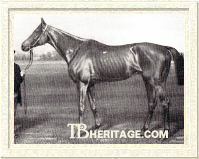
Hymenaeus
| | HYMENAEUS, an "elegantly made" colt with "hard legs," was purchased at the side of his dam, Cantata, in England from the Merry sale, and shipped to Germany, where they were bought by Gestüt Harzburg. Ulrich von Oertzen, who at that time took trips to England to buy mares for the Northern German breeding society, apparently had had his eye on the colt, and when he was auctioned off, purchased him for 2,200 Marks for his own stable. HYMENAEUS dead-heated with Seemans in the Deutches Derby, split the stakes with Seemanns' owner, and took the walk-over. He ran through age seven, taking 26 wins in 42 starts, and was second ten times. In Germany HYMENAEUS got two winners of the Deutsches St. Leger and other races, Battenberg and Blue Monkey, and other winners.
|
Lord Clifden's other sire sons got some good winners. These included KING OF TRUMPS (1875, Queen Bee by King Tom), sire of the good runner The Rejected, winner of the one mile Lincolnshire Handicap and other useful horses; BAREFOOT (1868, Stockings by Stockwell), sire of the 1886 Grand National Steeplechase winner Old Joe; CONJUROR (1866), who got Juggler (1870), an Irish Grand National winner; the aforementioned WINSLOW, who was purchased for 2,000 guineas by the royal stud manager Colonel Maude for Hampton Court and stood without much effect there for a few years after he retired from the turf, but did get the really good steeplechaser Roquefort (1879), winner of numerous high-class chases, including the Grand National, the Grand Sefton and the Champion Chase, all at Aintree. In France, Lord Clifden's son, LORD CLIVE (1875, Plunder by Buccaneer) got the filly La Moriniere, winner of the 1900 Prix du Jockey Club, and also a good jumper, Calabris, winner in 1900 of the Grand Steeple-Chase de Paris; he was later a useful dam's sire in France.
Lord Clifden's Daughters
With the exception of the blue-blooded, brilliant JANNETTE (1875, Chevisaunce (full sister to Derby winner Lord Lyon) by Stockwell), Lord Clifden's daughters were a modest lot on the turf, and, as a rule, not as powerful as his good sons in the breeding shed.
|
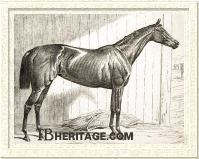
Jannette
| | JANNETTE, bred and raced by Lord Falmouth, won all seven of her starts as a juvenile, three of them walk-overs, including Ascot's triennial, Goodwood's Richmond Stakes, Newmarket First October's Clearwell Stakes, and Newmarket Houghton meeting's Criterion Stakes, winning in all about £5,260 that year and undisputed champion juvenile. The next year she was second to Pilgrimage in the One Thousand Guineas, and then won the Epsom Oaks, going on that year to also take the Champion Stakes, and a few days later the Newmarket Oaks, followed by the Yorkshire Oaks and the Doncaster St. Leger. The next year she won the 2-1/2 mile Jockey Club Cup. JANNETTE, always sound and described frequently as a "charming filly," was the dam of Janissary (1887, by Isonomy), a winner of Ascot's St. James's Palace Stakes and later sire of the 1898 long-shot Epsom Derby winner Jeddah. Her tail-female line bred on, with the important German sires Birkhahn and Burgermeister remote descendants.
|
Some of Lord Clifden's other good running fillies included REBECCA (1868, Sweet Hawthorn by Sweetmeat), who won the Yorkshire Oaks; LADY PATRICIA (1871, Lady Langford by Sir Hercules), winner of the 1876 Liverpool Spring Cup; MISS TOTO (1871, Baroness by Stockwell), a winner of Newmarket's Criterion Stakes, later sent to stud in France, and MANOEUVRE (1874, Quick March by Rataplan), a solid runner that won Goodwood's Gratwicke Stakes and placed second in Ascot's Coronation Stakes to Belphoebe and third in the Doncaster St. Leger (won by Silvio). MANOEUVRE was later the dam of the steeplechaser Flying Column (1885), a mare that won Aintree's Champion Chase in 1892, and of an Epsom Derby winner, Sir Hugo (1889 by Wisdom).
Among the many daughters of Lord Clifden that bred on, CELIBACY (1869, mare by Cowl), produced Scot Free (1881 by Macgregor), a winner of Newmarket's Craven Stakes and the Two Thousand Guineas at age three. MISS TOTO'S sister, LADY GOWER (1875) produced Galloping Dick, a winner of Goodwood's Richmond Stakes, and the French-bred Chasseur (1892), a winner of Goodwood's six furlong Steward's Cup in 1896. MA BELLE (1874, Dulcibella by Voltigeur) was the dam of two good juveniles, Child of the Mist (1882, by Blair Athol), who took Newmarket's Chesterfield Stakes, and Beau Brummel (1880, by George Frederick), a winner of Epsom's Woodcote Stakes and later a good sire of fillies. Lord Clifden's daughter ROSEDALE became the dam of the 1893 Northumberland Plate winner Seaton Delaval (1889 by Melton), and THE SCOTCH MIST (1873) produced Drizzle (1884, by Beauclerc), a mare that won the same race in 1889.
Lord Clifden's daughters beyond England included KISASSZONY (1869, The Little Woman by Kingston), born in Austria-Hungary; she was later the dam of seven good winners, including Maria (1880, by The Palmer), a winner of ten of her twelve races, including the Furstenberg Rennen and the Deutsches St. Leger. Another Lord Clifden daughter, LADY ROSEBERY (1872, Violet by Thormanby), a sister to BAY WINDHAM, bred three good-producing daughters, including Primrose Dame (1885, by Barcaldine), the dam of the French champion runner and thrice leading sire Perth (1896); Lady Rosebery's female line descendants have included many superior winners over the years, including Prix de l'Arc de Triomphe winners Priori and Sassafrass, and the half-brothers Prix du Jockey Club winner Bikala (1978) and Irish Derby winner Assert (1979). Another Lord Clifden daughter, REDPOLE (1874, Red Start by Blair Athol), sent to Italy, became dam of the Derby Italiano winner Enio (1883 by Hamlet). STATELY, sent to Austria-Hungary, produced Statesman, a winner of the Magyar St. Leger.
Lord Clifden's daughter INSTEP (1872, Sandal by Stockwell, and so closely related to WENLOCK'S daughter Sanda) was imported into South Australia by W. Blackler, where she established a superior female line that included some of the best of the antipodes, including the outstanding mare Desert Gold (1912) that won 32 of her 59 races in New Zealand and Australia, including all fourteen of her races in her three-year-old season, among them the New Zeland Derby and Oaks and the Great Northern Derby, Oaks and St. Leger. Another INSTEP tail-female descendant was Hydrogen (1948), that in 1953 became the all-time leading money winner in Australia. Closer in time to INSTEP were her grandchildren by Trenton, through daughter Aura (1886, by Richmond): Melbourne Cup winner Auraria, a tough race mare, and her brother Aurum, that won top races in Victoria and was later sent to a hapless stud career in England.
Lord Clifden unexpectedly died "from heart disease" after only a few years at Dewhurst on February 7, 1875, age 15, a loss bemoaned by turf writers that had come to consider him one of the few high class stallions of the time. It was one trip Gee could not take with his beloved stallion.
--Patricia Erigero
Special thanks to Cathy Schenck for assistance with Buckden's race record
|
|
|
|

